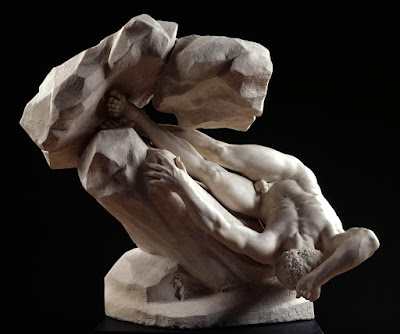 |
| Edward Burch Neptune 1771 carnelian intaglio (diploma work) Royal Academy of Arts, London |
 |
| Edward Burch Neptune ca. 1771 plaster cast of intaglio Royal Academy of Arts, London |
"The standing figure of Neptune, god of the sea, rests on his trident after having crowned the British navy with victory over the Spanish fleet during the Falklands crisis of 1770. At the time Burch joined the Academy he was already the foremost gem engraver in Britain. He took a lively part in Academy affairs and its social life, and was popular, though he was remembered as 'often coarse in both manner and expression.' By the end of the century the originality of his work, not conforming to the Neo-Classical canon – together with the artist's failing sight and a decline in demand for engraved gems – left him in penury. From 1794 he was appointed librarian to the Royal Academy, a post traditionally given to indigent artists."
 |
| Joseph Nollekens Cupid and Psyche 1773 marble relief (diploma work) Royal Academy of Arts, London |
 |
| Matthew William Peters Children 1777 oil on canvas (diploma work) Royal Academy of Arts, London |
"Peters was brought up in Dublin and studied at the first School of Design there before becoming a pupil of Thomas Hudson. He studied in Rome from 1762 until 1764 and again travelled to Italy and France in the 1770s and early 1780s. In 1782 he became an ordained priest and was chaplain to the Royal Academy from 1784-88."
 |
| John Bacon Sickness 1778 marble (diploma work) Royal Academy of Arts, London |
 |
| John Singleton Copley The Tribute Money 1782 oil on canvas (diploma work) Royal Academy of Arts, London |
"Copley chose to illustrate a Biblical theme for his Diploma Work. Strong lighting and bold colours emphasize Christ's importance, with the receding and monochrome apostles suitably varied in pose and appearance. Certain compositional elements were lifted by the artist from an engraving of the Rubens painting, Christ giving the Keys to St Peter."
 |
| John Francis Rigaud Samson and Delilah ca. 1784 oil on canvas (diploma work) Royal Academy of Arts, London |
"John Francis Rigaud was born and trained in Turin. He came to London in 1771 and quickly found success, being elected as Associate of the Royal Academy the following year. Rigaud chose to give this substantial historical painting to the Academy in part to advertise his ease and skill with dramatic narratives. Samson's pose is based on Michelangelo's fresco of Haman in the Sistine Chapel."
 |
| Thomas Banks The Falling Titan 1786 marble (diploma work) Royal Academy of Arts, London |
"Thomas Banks began studying at the Royal Academy Schools in 1769, one year after the institution's founding. In 1770 he earned a Gold Medal and the travelling scholarship to Rome. According to Lavinia Banks, the artist's daughter, he said of The Falling Titan that 'he conceived the subject to exist in the block of marble, a priori, and that it was called forth by the sculptor's hand.' Contemporaries were warm in their praise – 'for correctness of design, and masterly stile of execution, it seems to be superior to anything in that line that has yet been presented to the Academy."
 |
| John Opie Age and Infancy ca. 1786 oil on canvas (diploma work) Royal Academy of Arts, London |
 |
| James Northcote Jael and Sisera 1787 oil on canvas (diploma work) Royal Academy of Arts, London |
 |
| John Russell Naomi and Ruth 1788 pastel (diploma work) Royal Academy of Arts, London |
"A follower of the Methodist preacher George Whitefield (1714-1770), John Russell recorded his 'conversion' in his diary in September 1764. He continued to live by a strict moral code from that time onwards. He did not wish to appear 'disrespectful' by turning down invitations to dine at the Royal Academy, yet he disliked the general tone of conversation at such functions. Writing in 1773, for instance Russell complained that he was 'obliged to fly from the R.A. as they were full of filthy blasphemy."
 |
| Ozias Humphry A Fortune Teller ca. 1788 watercolour and gouache (diploma work) Royal Academy of Arts, London |
"This miniature was originally shown at the Royal Academy Annual Exhibition in 1788 with the title 'A Bramin in India telling the fortune of some English ladies.' An inscription on the reverse identifies the subjects as Lady Charlotte Maria and Lady Anne Horatia, daughters of the 2nd Earl Waldegrave."
 |
| William Hamilton Vertumnus and Pomona ca. 1789 oil on canvas (diploma work) Royal Academy of Arts, London |
"Hamilton studied in Rome under the painter Antonio Zucchi before entering the Royal Academy Schools in 1769. He exhibited at the Academy from 1774, showing both history paintings and portraits. In addition, he worked as a decorative painter for Robert Adam, helping to execute the latter's fashionable Neoclassical interiors."
 |
| Henry Fuseli Thor battling the Midgard Serpent 1790 oil on canvas (diploma work) Royal Academy of Arts, London |
"Fuseli's subject derives from the Icelandic sagas of the Edda, known in England from P.H. Mallet's book, Northern Antiquities (1770). This tableau – heroic figure wrestling with evil serpent – is given great grandeur and drama as it emerges from the inky background. Parallels have been drawn between this epic struggle and contemporary events in France. Fuseli was an enthusiastic supporter of the French Revolution, and Thor's battle with the serpent could be seen to mirror the French people's struggle against the ancien régime."
 |
| Francis Wheatley A Peasant Boy ca. 1790-91 oil on canvas (diploma work) Royal Academy of Arts, London |
– quoted texts adapted from Royal Academy notes